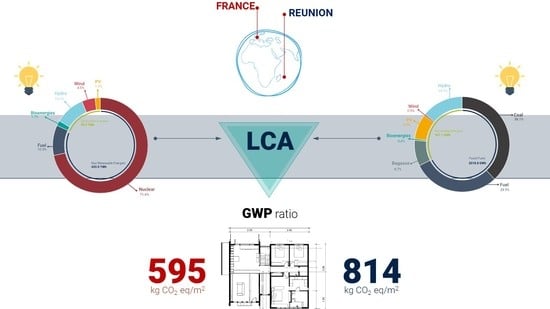Environmental Overcost of Single Family Houses in Insular Context: A Comparative LCA Study of Reunion Island and France
Abstract
1. Introduction
2. Context and Background
2.1. A Brief Overview of Reunion Island
2.2. Reunion Construction Sector Situation
2.3. A Brief Litterature Review
3. Methodology
3.1. Goal and Scope Definition
3.2. Functional Unit
- The definition of gross emission factors (FE) for Reunion and France.
- The quantification of these emission factors to obtain total emissions by impact category.
- Finally, the ratios per of area floor were calculated.
3.3. System Boundaries
3.4. Life Cycle Inventory
3.5. LCA Impact Categories
3.6. Measuring Insularity Effect
3.7. LCA Data Statistics
- l is the location and
- is the impact of factor i.
- and are the impacts of factor i, respectively, for Reunion island and France;
- subindex i refers to each studied house;
- and subindex j denotes each of the five impact factors.
4. Results
4.1. Environmental Impact at the House Level
4.2. Breakdown per Construction Process
4.3. Impact of Construction Materials
5. Discussion
5.1. Effect of Insularity
5.2. Policy Implications
- The first aspect is more of a technical nature, which aims to improve the boat’s components and also energy optimization in the operational phase [74].
- The second point concerns the integration of renewable energies for electricity generation, but also a transition to zero-carbon fuels.
6. Conclusions
Author Contributions
Funding
Acknowledgments
Conflicts of Interest
Abbreviations
| AP | Acidification Potential | [kg SO2eq] |
| ADP-E | Abiotic resource Depletion Potential elements | [kg Sbeq] |
| GHG | Greenhouse gases | - |
| GWP | Global Warming Potential | [kg CO2eq] |
| NMVOC | Non Methanic Volatils Organic Compound | [kg] |
| PRD | Percent Relative Deviation | - |
| RSD | Relative Standard Deviation | - |
| TOPP | Tropospheric Ozone Pollution Project | [kgeq] |
Appendix A
| ORIGIN | TRANSIT | DISTANCE (km) |
|---|---|---|
| SWEDEN | Suez Canal | 14,260 |
| Cape of Good Hope | 16,648 | |
| Panama Canal | 32,834 | |
| Strait of Magellan | 34,219 | |
| Cap Horn | 34,338 | |
| CAMEROUN | Cape of Good Hope | 8391 |
| Suez Canal | 16,899 | |
| Strait of Magellan | 29,126 | |
| Cape Horn | 29,198 | |
| Panama Canal | 33,078 | |
| COLOMBIA | Cape of Good Hope | 15,282 |
| Suez Canal | 17,940 | |
| Panama Canal | 23,696 | |
| Strait of Magellan | 30,545 | |
| Cape Horn | 30,663 | |
| CONGO | Cape of Good Hope | 7343 |
| Suez Canal | 17,353 | |
| Strait of Magellan | 28,485 | |
| Panama Canal | 33,471 | |
| Suez Canal | 14,260 | |
| SWEDEN | Cape of Good Hope | 10,167 |
| Suez Canal | 18,482 | |
| BRAZIL | Strait of Magellan | 23,187 |
| Cape Horn | 23,344 | |
| Panama Canal | 31,174 | |
| CANADA | Suez Canal | 14,816 |
| Cape of Good Hope | 15,588 | |
| Panama Canal | 27,963 | |
| Strait of Magellan | 31,735 | |
| Cape Horn | 31,856 | |
| FRANCE | Suez Canal | 9430 |
| Cape of Good Hope | 14,810 | |
| Strait of Magellan | 32,413 | |
| Panama Canal | 32,484 | |
| Cape Horn | 32,528 | |
| GABON | Cape of Good Hope | 7565 |
| Suez Canal | 17,071 | |
| Strait of Magellan | 28,467 | |
| Cape Horn | 28,493 | |
| Panama Canal | 33,223 | |
| RUSSIA | Suez Canal | 16,527 |
| Cape of Good Hope | 18,871 | |
| Panama Canal | 34,239 | |
| Strait of Magellan | 36,345 | |
| Cape Horn | 36,465 | |
| BELGIUM | Suez Canal | 13,012 |
| Cape of Good Hope | 15,399 | |
| Panama Canal | 31,971 | |
| Strait of Magellan | 32,971 | |
| Cape Horn | 33,089 | |
| CHINA | Direct | 9395 |
| ESTONIA | Suez Canal | 15,003 |
| Cape of Good Hope | 17,390 | |
| Panama Canal | 33,576 | |
| Strait of Magellan | 34,962 | |
| Cape Horn | 3508 | |
| FINLAND | Suez Canal | 14,940 |
| Cape of Good Hope | 17,327 | |
| Panama Canal | 33,513 | |
| Strait of Magellan | 34,899 | |
| Cape Horn | 35,017 | |
| GREECE | Suez Canal | 7628 |
| Cape of Good Hope | 16,432 | |
| Strait of Magellan | 34,036 | |
| Panama Canal | 34,106 | |
| Cape Horn | 34,150 | |
| GERMANY | Suez Canal | 7628 |
| Cape of Good Hope | 16,432 | |
| Strait of Magellan | 34,036 | |
| Panama Canal | 34,106 | |
| Cape Horn | 34,150 | |
| INDONESIA | Direct | 13,386 |
| INDIA | Direct | 8113 |
| ITALY | Suez Canal | 9148 |
| Cape of Good Hope | 16,271 | |
| Strait of Magellan | 33,874 | |
| Panama Canal | 33,945 | |
| Cape Horn | 34,360 | |
| MADAGASCAR | Direct | 1435 |
| MORROCO | Suez Canal | 11,293 |
| Cape of Good Hope | 12,667 | |
| Strait of Magellan | 30,400 | |
| Cape Horn | 30,509 | |
| Panama Canal | 30,733 | |
| SINGAPORE | Direct | 6389 |
| SOUTH AFRICA | Direct | 6389 |
| TURKEY | Direct | 6389 |
| USA | Direct | 19,305 |
| ORIGIN | TRANSIT | DISTANCE (km) |
|---|---|---|
| GERMANY | GREAT EAST (Road) | 1128 |
| AIRPORT ERF and MCU (Flight) | 823.45 | |
| BELGIUM | ILE DE FRANCE (Road) | 706.27 |
| AIRPORT BRU and MCU (Flight) | 543.27 | |
| SPAIN | SAINT JEAN DE LUZ (Road) | 1091.47 |
| AIRPORT ECV and MCU (Flight) | 818.89 | |
| PORTUGAL | CASTILLA LEON (Road) | 1355.73 |
| AIRPORT LIS and MCU (Flight) | 1252 | |
| SWEDEN | HAMBURG (Road) | 2480.02 |
| AIRPORT EVG AND MCU (Flight) | 1920.39 | |
| ROMANIA | OSTERREICH (Road) | 2339.78 |
| AIRPORT TGM and MCU (Flight) | 1687.67 | |
| ITALY | PIEMONTE (Road) | 1187.65 |
| AIRPORT PEG and MCU (Flight) | 874.23 | |
| FINLAND | COPENHAGEN (Road) | 3242.70 |
| AIRPORT OUL and MCU (Flight) | 2502.62 | |
| UNITED STATES | AIRPORT RSL and MCU (Flight) | 7740.48 |
| RUSSIA | KIROV (Road) | 7727.82 |
| AIRPORT UIK and ORY (Flight) | 6093.34 | |
| AUSTRIA | AIRPORT ASP and MCU (Flight) | 15,053 |
| Single Family Houses | GWP | ADP-E | AP | TOPP | NMVOC | |||||
|---|---|---|---|---|---|---|---|---|---|---|
| Réunion | France | Réunion | France | Réunion | France | Réunion | France | Réunion | France | |
| SFH 1 | 977.52 | 658.71 | 1.76× 10 | 1.04 × 10 | 2.35 | 1.36 | 3.35 | 1.97 | 8.91 × 10 | 5.42 × 10 |
| SFH 2 | 736.64 | 546.83 | 2.15 × 10 | 1.26 × 10 | 1.4 | 1.21 | 2.74 | 1.74 | 8.48 × 10 | 6.36 × 10 |
| SFH 3 | 1177.05 | 841.71 | 2.23 × 10 | 1.63 × 10 | 2.96 | 1.85 | 4.28 | 2.73 | 1.54 | 1.12 |
| SFH 4 | 558.41 | 399.38 | 1.29 × 10 | 8.73 × 10 | 1.5 | 0.86 | 1.99 | 1.17 | 5.92 × 10 | 3.70 × 10 |
| SFH 5 | 744.67 | 506.52 | 4.42 × 10 | 1.02 × 10 | 1.8 | 1.06 | 2.55 | 1.52 | 6.68 × 10 | 4.18 × 10 |
| SFH 6 | 717.93 | 489.22 | 4.82 × 10 | 1.03 × 10 | 1.82 | 1.06 | 2.47 | 1.47 | 6.88 × 10 | 4.36 × 10 |
| SFH 7 | 1057.79 | 745.71 | 1.66 × 10 | 1.44 × 10 | 2.65 | 1.47 | 3.67 | 2.07 | 1.07 | 5.95 × 10 |
| SFH 8 | 517.40 | 404.23 | 1.24 × 10 | 1.56 × 10 | 2.01 | 0.84 | 1.87 | 1.21 | 1.60 | 4.22 × 10 |
| SFH 9 | 1143.49 | 818.47 | 2.16 × 10 | 1.59 × 10 | 2.88 | 1.8 | 4.17 | 2.67 | 1.51 | 1.10 |
| SFH 10 | 851.51 | 619.19 | 2.03 × 10 | 1.37 × 10 | 2.38 | 1.53 | 3.37 | 2.2 | 1.53 | 1.15 |
| SFH 11 | 789.92 | 633.21 | 2.14 × 10 | 1.44 × 10 | 2.06 | 1.42 | 2.93 | 2.11 | 8.97 × 10 | 8.64 × 10 |
| SFH 12 | 824.70 | 616.15 | 2.08 × 10 | 1.47 × 10 | 2.16 | 1.37 | 3.04 | 1.97 | 9.48 × 10 | 7.35 × 10 |
| SFH 13 | 1005.00 | 722.38 | 1.64 × 10 | 1.63 × 10 | 2.63 | 1.68 | 3.76 | 2.45 | 1.49 | 1.11 |
| SFH 14 | 891.15 | 632.94 | 1.52 × 10 | 1.25 × 10 | 2.2 | 1.36 | 3.17 | 1.99 | 9.48 × 10 | 6.85 × 10 |
| SFH 15 | 804.96 | 571.72 | 1.42 × 10 | 1.13 × 10 | 1.99 | 1.22 | 2.86 | 1.8 | 8.56 × 10 | 6.19 × 10 |
| SFH 16 | 601.81 | 526.16 | 1.29 × 10 | 1.08 × 10 | 1.38 | 1.13 | 1.99 | 1.66 | 5.00 × 10 | 6.07 × 10 |
| SFH 17 | 609.09 | 502.87 | 1.16 × 10 | 1.07 × 10 | 1.39 | 1.06 | 2.03 | 1.51 | 5.00 × 10 | 4.43 × 10 |
| SFH 18 | 852.49 | 619.35 | 2.46 × 10 | 1.42 × 10 | 2.1 | 1.59 | 3.11 | 2.29 | 1.54 | 1.28 |
| SFH 19 | 821.03 | 614.58 | 1.92 × 10 | 1.90 × 10 | 2.08 | 1.33 | 2.99 | 1.95 | 9.22 × 10 | 7.14 × 10 |
| SFH 20 | 607.59 | 444.45 | 1.66 × 10 | 1.01 × 10 | 1.81 | 1.14 | 2.54 | 1.63 | 1.26 | 9.12 × 10 |
| Ratio | 814.51 | 595.69 | 1.64 × 10 | 1.95 × 10 | 2.08 | 1.32 | 2.94 | 1.91 | 1.04 | 7.37 × 10 |
References
- Nwodo, M.N.; Anumba, C.J. A review of life cycle assessment of buildings using a systematic approach. Build. Environ. 2019, 162, 106290. [Google Scholar] [CrossRef]
- ADEME. Rénover son Logement à La Réunion. Quels Travaux, Avec Quels Professionnels et Quelles Aides? Technical Report; ADEME: Angers, France, 2018. [Google Scholar]
- Pacheco-Torgal, F.; Cabeza, L.F.; Labrincha, J.; De Magalhaes, A.G. Eco-Efficient Construction and Building Materials: Life Cycle Assessment (LCA), Eco-Labelling and Case Studies; Woodhead Publishing: Cambridge, UK, 2014. [Google Scholar]
- Chirjiv Kaur Anand, B.A. Recent developments, futurs challenges and new research directions in LCA of buildings: A critical review. Renew. Sustain. Energy Rev. 2017, 67, 408–416. [Google Scholar] [CrossRef]
- Vilches, A.; Garcia-Martinez, A.; Sanchez-Montanes, B. Life cycle assessment (LCA) of building refurbishment: A litterature review. Energy Build. 2017, 135, 286–301. [Google Scholar] [CrossRef]
- Martínez-Rocamora, A.; Solís-Guzmán, J.; Marrero, M. LCA databases focused on construction materials: A review. Renew. Sustain. Energy Rev. 2016, 58, 565–573. [Google Scholar] [CrossRef]
- Asdrubali, F.; D’Alessandro, F.; Schiavoni, S. A review unconventional sustainable building insulation materials. Sustain. Mater. Technol. 2015, 4, 1–17. [Google Scholar] [CrossRef]
- Turconi, R.; Boldrin, A.; Astrup, T. Life cycle assessment (LCA) of electricity generation technologies: Overview, comparability and limitations. Renew. Sustain. Energy Rev. 2013, 28, 555–565. [Google Scholar] [CrossRef]
- Oduyemi, O.; Okoroh, M.I.; Fajana, O. The application and barriers of BIM in sustainable building design. J. Facil. Manag. 2017, 15, 15–34. [Google Scholar] [CrossRef]
- Malia, E.; Lewis, G. Life cycle greenhouse gas emissions of electricity generation in the province of Ontario, Canada. Int. J. Life Cycle Assess. 2013, 18, 377–391. [Google Scholar] [CrossRef]
- Chau, C.K.; Leung, T.M.; Ng, W.Y. A review on life cycle assessment, life cycle energy assessment and life cycle carbon emissions assessment on buildings. Appl. Energy 2015, 143, 395–413. [Google Scholar] [CrossRef]
- Sharma, A.; Saxena, A.; Sethi, M.; Shree, V. Life cycle assessment of buildings: A review. Renew. Sustain. Energy Rev. 2011, 15, 871–875. [Google Scholar] [CrossRef]
- Abd Rashid, A.F.; Yussoff, S. A review of life cycle assessment method for building industry. Renew. Sustain. Energy Rev. 2015, 45, 244–248. [Google Scholar] [CrossRef]
- Soust-Verdaguer, B.; Llatas, C.; García-Martínez, A. Simplification in life cycle assessment of single-family houses: A review of recent developments. Build. Environ. 2016, 103, 215–227. [Google Scholar] [CrossRef]
- Schlegl, F.; Gantner, J.; Traunspurger, R.; Albrecht, S.; Leistner, P. LCA of buildings in Germany: Proposal for a future benchmark based on existing databases. Energy Build. 2019, 194, 342–350. [Google Scholar] [CrossRef]
- Dong, Y.H.; Ng, S.T. A life cycle assessment model for evaluating the environmental impacts of building construction in Hong Kong. Build. Environ. 2013, 89, 183–191. [Google Scholar] [CrossRef]
- Dong, Y.H.; Jaillon, L.; Chu, P. Comparing carbon emissions of precast and cast and cast-in-situ construction methods—A case study of high-rise private building. Constr. Build. Mater. 2015, 99, 39–53. [Google Scholar] [CrossRef]
- Morales, M.; Moraga, G.; Kirchheim, A.P. Regionalized inventory data in LCA of public housing: A comparison between two conventional typologies in southern Brazil. J. Clean. Prod. 2019, 238, 117869. [Google Scholar] [CrossRef]
- Praene, J.P.; David, M.; Sinama, F.; Morau, D.; Marc, O. Renewable energy: Progressing towards a net zero energy island, the case of Reunion Island. Renew. Sustain. Energy Rev. 2012, 16, 426–442. [Google Scholar] [CrossRef]
- DEAL. Chiffres & Statistiques Logement et Construction; Technical Report; DEAL: Paris, France, 2019. [Google Scholar]
- DEAL. Les Besoins en Logement à La Réunion à L’Horizon 2035; Technical Report; DEAL: Paris, France, 2018. [Google Scholar]
- Curran, M. Life-Cycle Assessment. In Encyclopedia of Ecology; Elsevier: Amsterdam, The Netherlands, 2016; pp. 359–366. [Google Scholar] [CrossRef]
- Baumann, H. The Hitch Hiker’s Guide to LCA—An orientation in LCA methodology and application. Int. J. Life Cycle Assess. 2006, 11, 142. [Google Scholar] [CrossRef]
- Gantner, J.; Wittstock, B.; Lenz, K.; Fischer, M.; Sedlbauer, K.; Anderson, J.; Saunders, T.; Gyetvai, Z.; Carter, C.; Braune, A.; et al. EeBGuide Guidance Document Part B: Buildings. Operational Guidance for Life Cycle Assessment Studies of the Energy Efficient Building Initiative; Fraunhofer Verlag: Stuttgart, Germany, 2015. [Google Scholar]
- Klöpffer, W. The role of SETAC in the development of LCA. Int. J. Life Cycle Assess. 2006, 11, 116–122. [Google Scholar] [CrossRef]
- Asdrubali, F.; Baldassarri, C.; Fthenakis, V. Life cycle analysis in the construction sector: Guiding the optimization of conventional Italian buildings. Energy Build. 2013, 64, 73–89. [Google Scholar] [CrossRef]
- Lotteau, M.; Yepez-Salmon, G.; Salmon, N. Environmental assessment of sustainable neighborhood projects through NEST, a decision support tool for early stage urban planning. Procedia Eng. 2015, 115, 69–76. [Google Scholar] [CrossRef]
- Fouquet, M.; Levasseur, A.; Margni, M.; Lebert, A.; Lasvaux, S. Methodological challenges and developments in LCA of low energy buildings: Applications to biogenic carbon and global warming assessment. Build. Environ. 2015, 90, 51–59. [Google Scholar] [CrossRef]
- Atmaca, A.; Atmaca, N. Life cycle energy (LCEA) and carbon dioxide emissions (LCCO2A) assessment of two residential buildings in Gaziantep. Turkey. Energy Build. 2015, 102. [Google Scholar] [CrossRef]
- Chastas, P.; Theodosiou, T.; Karolos, J.; Kontoleon, D.B. Embodied energy in residential buildings-towards the nearly zero energy buildings: A literature review. Build. Environ. 2016, 105, 267–282. [Google Scholar] [CrossRef]
- Huang, B.; Xing, K.; Pullen, S. Energy and carbon performance evaluation for buildings and urban precincts: Review and a new modelling concept. J. Clean. Prod. 2015, 163, 24–35. [Google Scholar] [CrossRef]
- Kamali, M.; Hewage, K. Life cycle performance of modular of modular buildings: A critical review. Renew. Sustain. Energy Rev. 2016, 62, 1171–1183. [Google Scholar] [CrossRef]
- Soust-Verdaguer, B.; Llatas, C.; García-Martínez, A. Critical review of bim-based LCA method to buildings. Energy Build. 2017, 136, 110–120. [Google Scholar] [CrossRef]
- Kylili, A.; Fokaides, P.A. Life Cycle Assessment (LCA) of Phase Change Materials (PCMs) for building applications: A review. J. Build. Eng. 2016, 6, 133–143. [Google Scholar] [CrossRef]
- Fujita, Y.; Matsumoto, H.; Ho, C. Life Cycle Assessment Using Input-Output Analysis of CO2 emissions from Housing in Malaysia. In Proceedings of the International Conference on Sustainable Energy Technologies, Seoul, Korea, 24–27 August 2008. [Google Scholar]
- Omar, W.M.S.W.; Doh, J.H.; Panuwatwanich, K. Assessment of the Embodied Carbon in Precast Concrete Wall Panels Using a Hybrid Life Cycle Assessment Approach in Malaysia. Sustain. Cities Soc. 2014, 10, 101–111. [Google Scholar] [CrossRef]
- Wen, T.J.; Siong, H.C.; Noor, Z.Z. Assessment of Embodied Energy and Global Warming Potential of Building Construction Using Life Cycle Analysis Approach: Case studies of Residential Buildings in Iskandar Malaysia. Energy Build. 2014, 93, 295–302. [Google Scholar] [CrossRef]
- Marsono, A.K.B.; Balasbaneh, A.T. Combinations of building Construction Material for Residential Building for the Global Warming Mitigation for Malaysia. Constr. Build. Mater. 2015, 85, 100–108. [Google Scholar] [CrossRef]
- Tabatabaee, S.; Weil, B.S.; Aksamija, A. Negative life-cycle emissions growth rate through retrofit of existing institutional buildings. In Proceedings of the ARCC Conference, Chicago, IL, USA, 6–9 April 2015; pp. 212–221. [Google Scholar]
- Schwartz, Y.; Raslan, R.; Mumovic, D. Implementing multi objective genetic algorithm for life cycle carbon footprint and life cycle cost minimisation: A building refurbishment case study. Energy 2016, 97, 58–68. [Google Scholar] [CrossRef]
- Venbroucke, M.; Galle, W.; De Temmerman, N. Using life cycle assessment to inform decision-making for sustainable buildings. Buildings 2015, 5, 536–559. [Google Scholar] [CrossRef]
- Bonamente, E. Carbon and energy footprint of prefabricated industrial buildings: A systematic life cycle assessment analysis. Energies 2015, 8, 12685–12701. [Google Scholar] [CrossRef]
- Zhang, Z.; Cao, X.; Li, X. A comparative study of environmental performance between prefabricated and traditional residential buildings in China. J. Clean. Prod. 2015, 109, 131–143. [Google Scholar] [CrossRef]
- Debacker, W.; Buyle, M.; Audenaert, A. Towards a more sustainable building stock: Optimizing a flemish dwelling using life cycle approach. Buildings 2015, 5, 424–448. [Google Scholar]
- Zhang, X.; Wang, F. Life-cycle assessment and control measures for carbon emissions of typical buildings in China. Build. Environ. 2015, 86, 89–97. [Google Scholar] [CrossRef]
- Chang, Y.; Huang, Z.; Ries, R.J.; Masanet, E. The embodied air pollutant emission and water footprints of buildings in China: A quantification using disagregated input-output life cycle inventory model. J. Clean. Prod. 2015, 38, 6597–6603. [Google Scholar] [CrossRef]
- Ge, J.; Luo, X.; Hu, J.; Chen, S. Life cycle energy analysis of museum buildings: A case study of museums in Hangzhou. Energy Build. 2015, 109. [Google Scholar] [CrossRef]
- Savaresi, A. The Paris Agreement: A new beginning? J. Energy Nat. Resour. 2016, 34, 16–26. [Google Scholar]
- Jong, M.D.; Joss, S.; Schraven, D.; Weijnen, M. Sustainable-smart-resilient-low carbon-eco-knowledge cities; making sense of a multitude of concepts promoting sustainable urbanization. J. Clean. Prod. 2015, 109, 25–38. [Google Scholar] [CrossRef]
- Réglementation Thermique, Acoustique et Aération DROMs. 2016. Available online: http://www.reunion.developpement-durable.gouv.fr/reglementation-thermique-acoustique-et-aeration-r162.html (accessed on 5 April 2020).
- ISO. Environmental Management Life Cycle Assessment—Requirements And Guidelines; ISO 14040, Technical Report; Standard International Organization for Standardisation: Geneva, Switzerland, 2006. [Google Scholar]
- ISO. 14044 (2006) NF EN ISO 14044: 2006–Environmental Management–Life Cycle Assessment–Requirements and Guidelines; Standard International Organization for Standardisation: Geneva, Switzerland, 2006. [Google Scholar]
- UE. Contribution des ouvrages de construction au Développement durable—Déclarations Environnementales sur les Produits; UE: Brussels, Belgium, 2014. [Google Scholar]
- IINAS. Databases for Global Emissions Model for Integrated Systems (GEMIS); Technical Report; IINAS: Darmstadt, Germany, 2019. [Google Scholar]
- Öko- Institut. Global Emissions Model for Integrated Systems (GEMIS); Technical Report; Öko- Institut: Freiburg, Germany, 2015. [Google Scholar]
- OER. Bilan énergétique de la Réunion; Technical Report; Horizon Réunion: Saint-Leu, La Réunion, France, 2019. [Google Scholar]
- CEN. EN 15978—Sustainability of Construction Works—Assessment of Environmental Performance of Buildings—Calculation Method; Technical Report; CEN: Brussels, Belgium, 2011. [Google Scholar]
- CEN. EN 15804–Standards Publication Sustainability of Construction Works—Environmental Product Declarations—Cole Rules for the Product Category of Construction Products. European Committee for Standardization; Technical Report; CEN: Brussels, Belgium, 2013. [Google Scholar]
- Solomon, S. IPCC (2007): Climate change the physical science basis. AGUFM 2007, 2007, U43D-01. [Google Scholar]
- CML. CML’s Impact Assessment Methods and Characterisation Factors; Technical Report; Institute of Environmental Science: Leiden, The Netherlands, 2001. [Google Scholar]
- Simon, T. Une île en mutation: Infrastructures, aménagement et développement à La Réunion. EchoGéo 2008, 7. [Google Scholar] [CrossRef]
- Zhang, X.; Shen, L.; Zhang, L. Life cycle assessment of the air emissions during building construction process: A case study in Hong Kong. Renew. Sustain. Energy Rev. 2013, 17, 160–169. [Google Scholar] [CrossRef]
- Hoxha, E.; Habert, G.; Lasvaux, S.; Chevalier, J.; Le Roy, R. Influence of construction material uncertainties on residential building LCA reliability. J. Clean. Prod. 2017, 144, 33–47. [Google Scholar] [CrossRef]
- Kamali, M.; Hewage, K.; Sadiq, R. Conventional versus modular construction methods: A comparative cradle-to-gate LCA for residential buildings. Energy Build. 2019, 204, 109479. [Google Scholar] [CrossRef]
- Abd Rashid, A.F.; Idris, J.; Yusoff, S. Environmental impact analysis on residential building in malaysia using life cycle assessment. Sustainability 2017, 9, 329. [Google Scholar] [CrossRef]
- Briguglio, L. Small island developing states and their economic vulnerabilities. World Dev. 1995, 23, 1625–1632. [Google Scholar] [CrossRef]
- Bass, S.M. Ecology and eConomics in Small Islands: Constructing a Framework for Sustainable Development; Springer: Berlin/Heidelberg, Germany, 1993. [Google Scholar]
- Benard-Sora, F.; Praene, J.P. Territorial analysis of energy consumption of a small remote island: Proposal for classification and highlighting consumption profiles. Renew. Sustain. Energy Rev. 2016, 59, 636–648. [Google Scholar] [CrossRef]
- Kahhat, R.; Crittenden, J.; Sharif, F.; Fonseca, E.; Li, K.; Zhang, P. Environmental impacts over the life cycle of residential buildings using different exterior wall systems. J. Infrastruct. Syst. 2009, 15, 211–221. [Google Scholar] [CrossRef]
- ELAN-OI. Etude relative à la formation des prix de matériaux de construction à La Réunion; Technical Report; ELAN-OI: Saint-Denis, La Réunion, France, 2015. [Google Scholar]
- Chae, S.H.C.; Chang, U. A study on life cycle CO2 emissions of low-carbon building in South Korea. Sustainability 2016, 8, 579. [Google Scholar] [CrossRef]
- Rakotoson, V.; Praene, J.P. A life cycle assessment approach to the electricity generation of french overseas territories. J. Clean. Prod. 2017, 168, 755–763. [Google Scholar] [CrossRef]
- Rakotoson, V. Intégration de l’analyse de cycle de vie dans l’étude de la production électrique en milieux insulaires. Ph.D. Thesis, Université de la Reunion, La Réunion, France, 2018. [Google Scholar]
- Olmer, N.; Comer, B.; Roy, B.; Mao, X.; Rutherford, D. Greenhouse Gas Emissions from Global Shipping, 2013–2015 Detailed Methodology; International Council on Clean Transportation: Washington, DC, USA, 2017; pp. 1–38. [Google Scholar]
- Batiactu. Batiactu. Emploi dans la Construction; Batiactu: Paris, France, 2018. [Google Scholar]
- Sea-Distances. Available online: https://sea-distances.org/ (accessed on 5 April 2020).
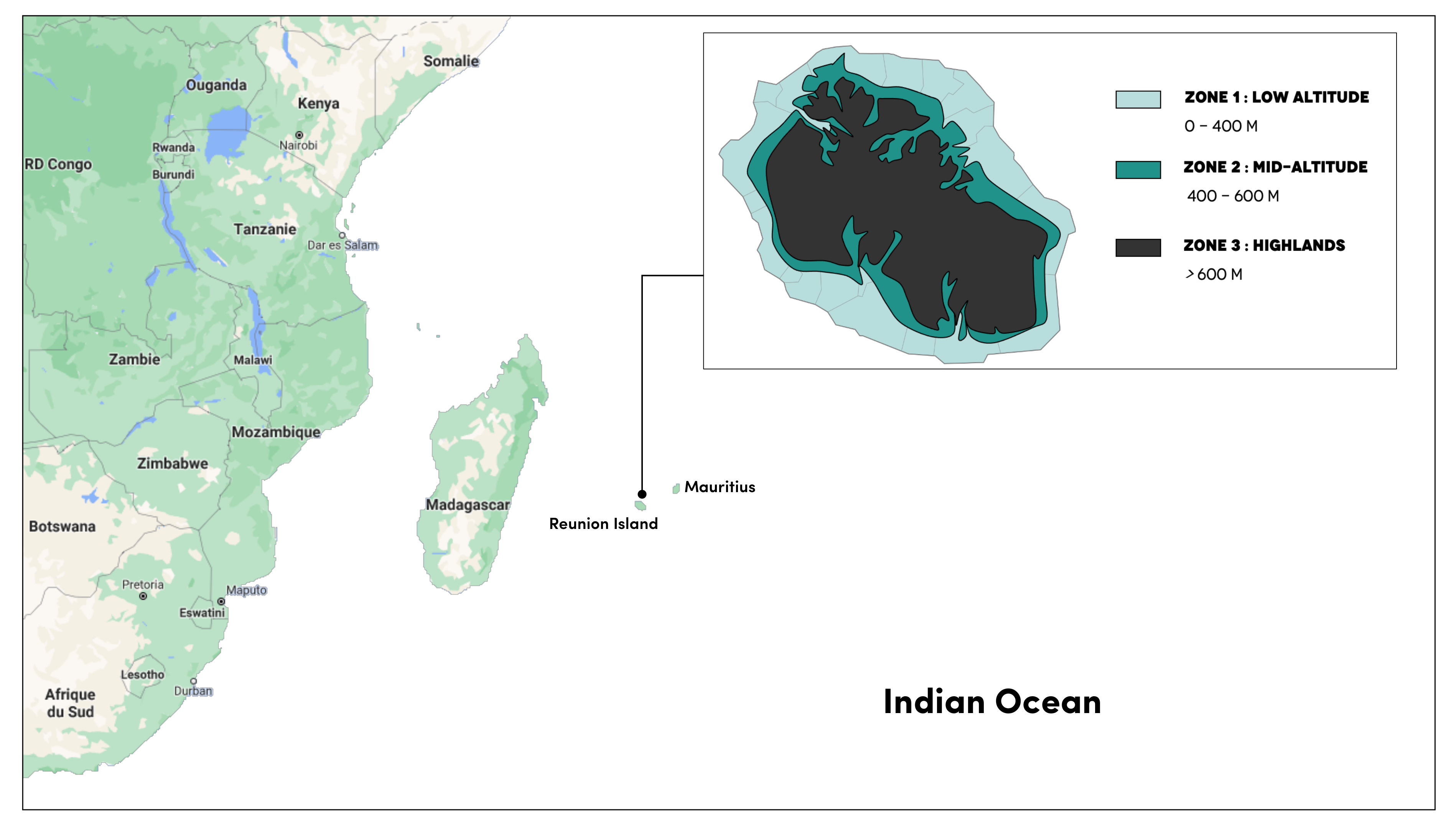
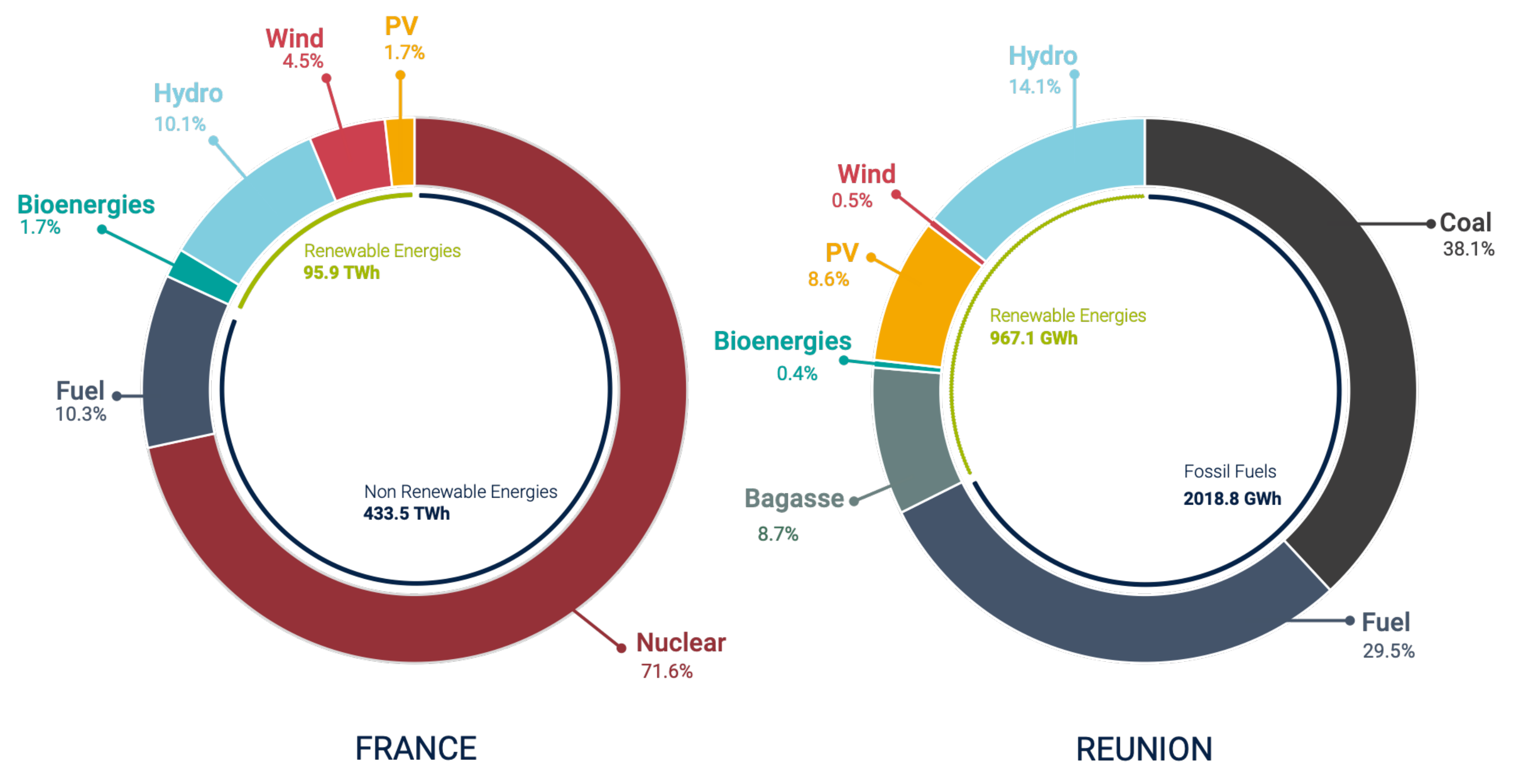
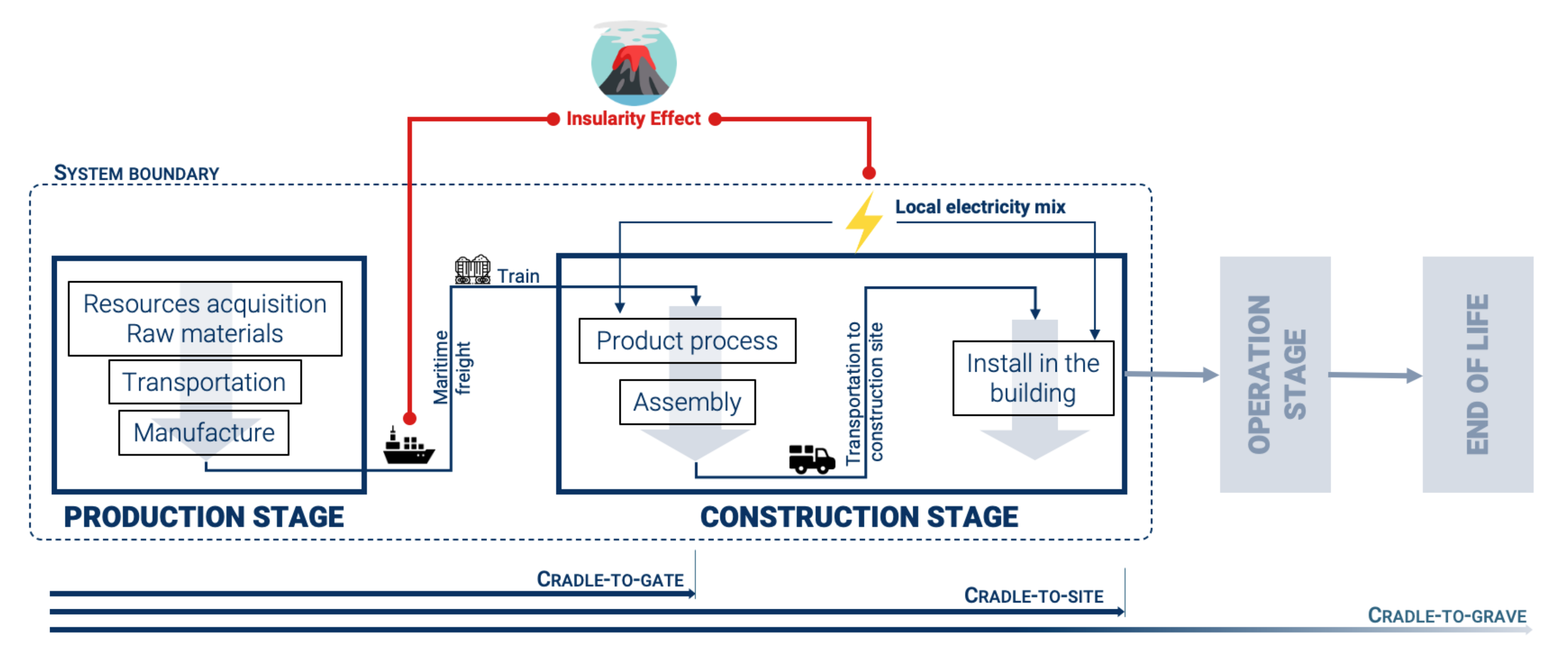
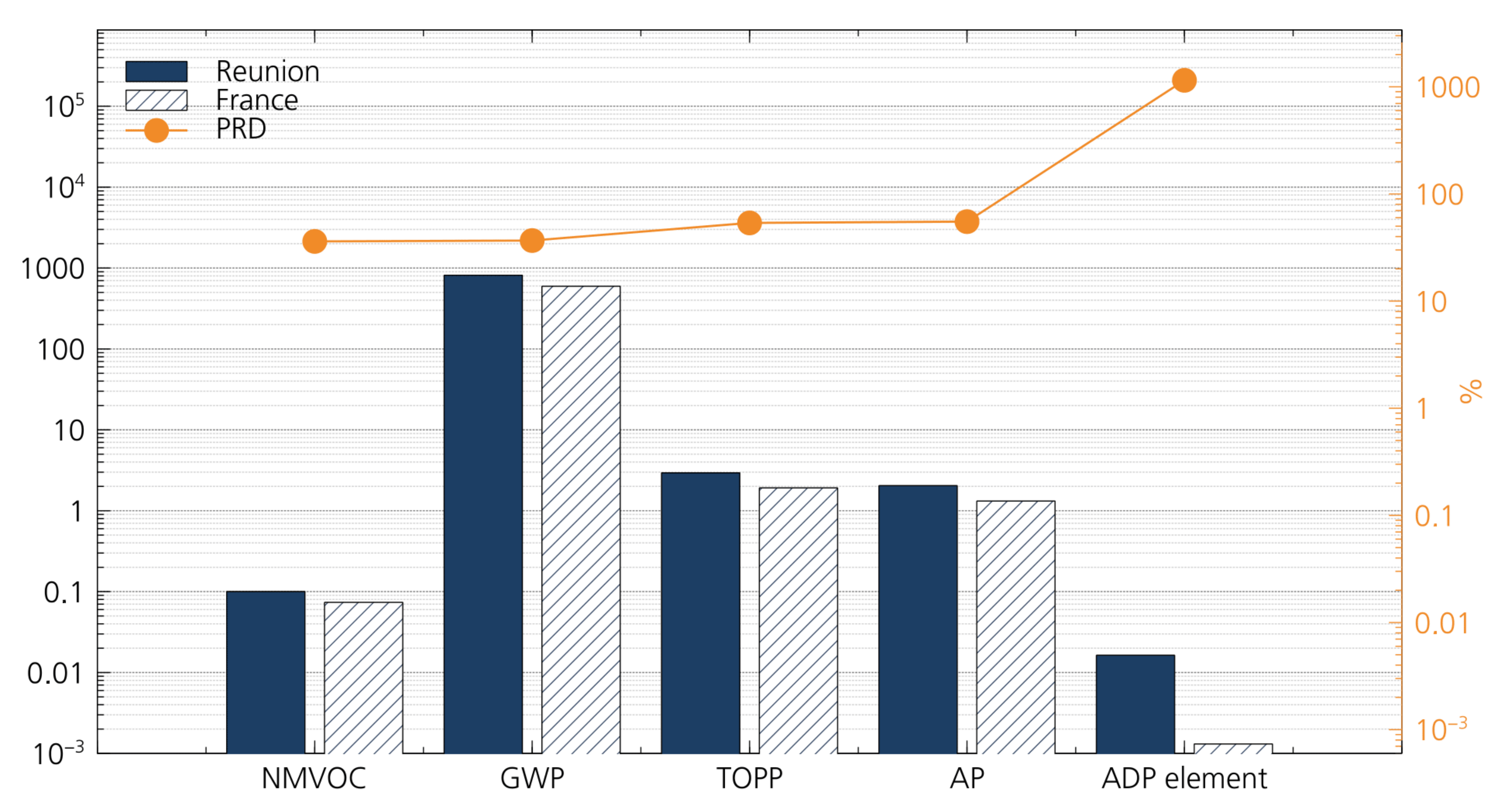
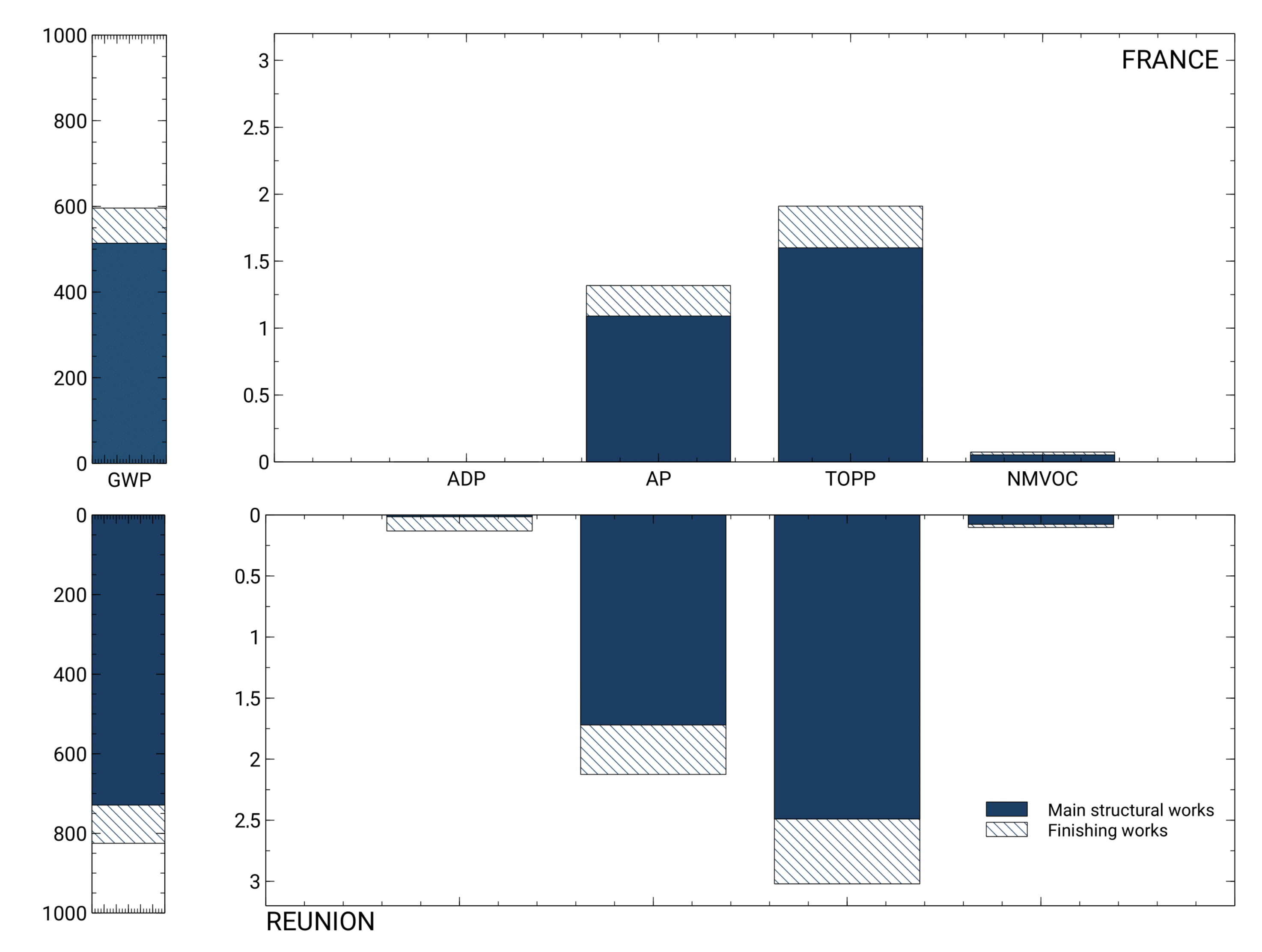
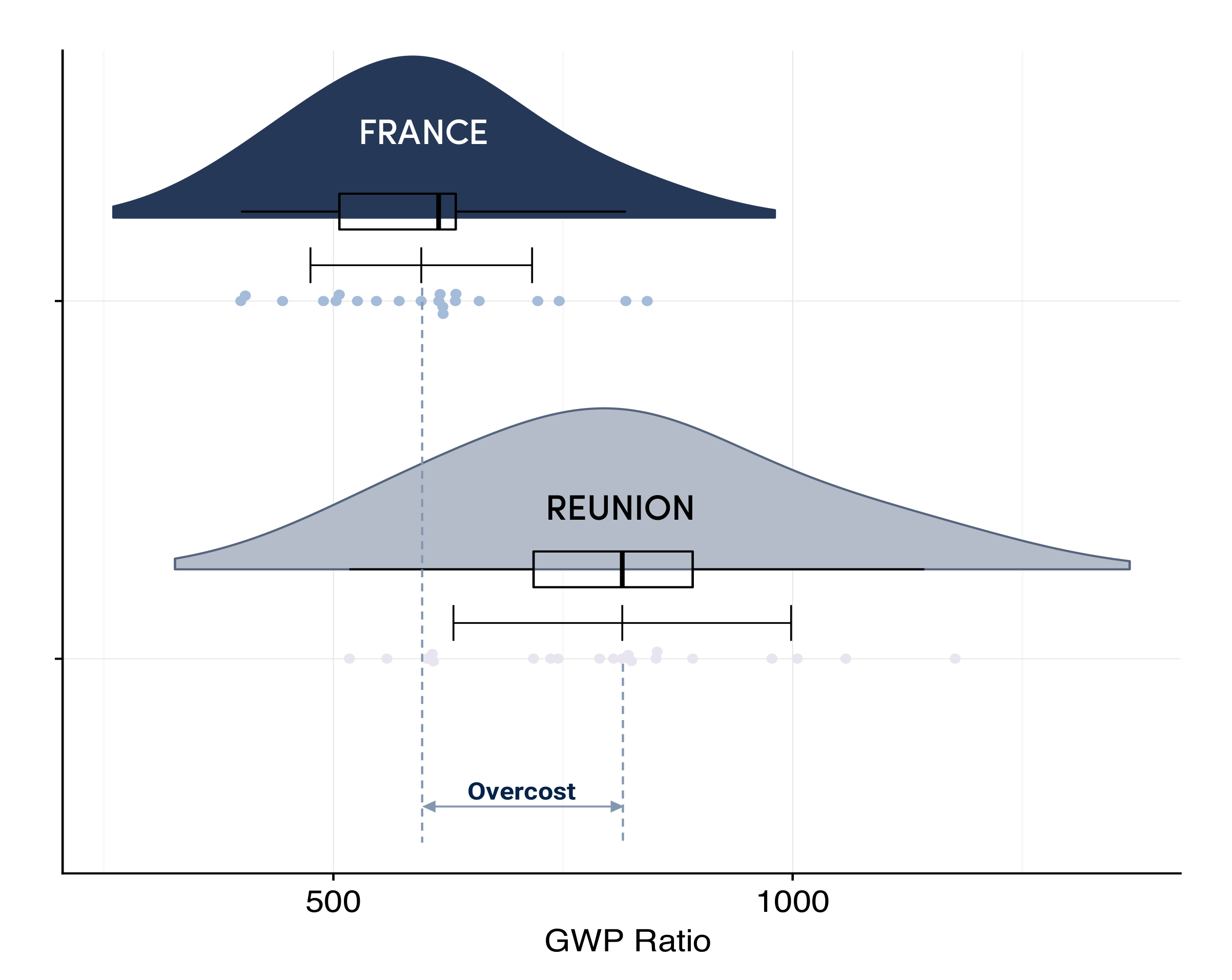

| Building Material | Distance of Transportation (km) | Modal Distribution | Distance of Transportation from the Industry to the Construction Site (km) | Modal Distribution |
|---|---|---|---|---|
| Cement | 0 | Maritim freight | 51 | Freight lorry |
| Aluminium | 14,139 | Maritim freight | 66 | Freight lorry |
| Ceramic tile | 9148 | Maritim freight | 66 | Freight lorry |
| Galvanized steel | 13,386 | Maritim freight | 56 | Freight lorry |
| Glass | 9395 | Maritim freight | 56 | Freight lorry |
| Gravel | 0 | Maritim freight | 51 | Freight lorry |
| Gypsum board | 12,400 | Maritim freight | 78 | Freight lorry |
| Paint | 6389 | Maritim freight | 56 | Freight lorry |
| Reinforcing steel | 9395 | Maritim freight | 14 | Freight lorry |
| Wood | 14,940 | Maritim freight | 14 | Freight lorry |
| Sand | 0 | Maritim freight | 51 | Freight lorry |
| NMVOC | GWP | TOPP | AP | ADP Element | ||||||
|---|---|---|---|---|---|---|---|---|---|---|
| Reunion | France | Reunion | France | Reunion | France | Reunion | France | Reunion | France | |
| 0.100 | 0.074 | 814.507 | 595.689 | 2.943 | 1.916 | 2.043 | 1.317 | 0.016 | 0.002 | |
| 0.035 | 0.028 | 188.571 | 123.786 | 0.701 | 0.419 | 0.500 | 0.284 | 0.005 | 0.003 | |
| RSD | 35.24 | 38.53 | 23.15 | 20.78 | 23.82 | 21.87 | 24.49 | 21.56 | 33.47 | 148.84 |
| 26.72 | 26.34 | 34.29 | 34.66 | 88.16 | ||||||
| Authors | Type of Building | GWP (kg ) |
|---|---|---|
| Ya Hong Dong et al. [16] | Residential building | 669 |
| Endrit Hoxha et al. [63] | Single Family Houses | 415–615–1085 |
| Residential buildings | 575–1035–910 | |
| Mohammad Kamali et al. [64] | Single family buildings | 979–860–978 |
| Michele Morales et al. [18] | Public housing | 750–1000 |
| Ahmad Faiz Rashid et al. [65] | Residential building | 828 |
| Our case study-France | Single Family Houses | 575 |
| Our case study-Reunion | Single Family Houses | 814 |
Publisher’s Note: MDPI stays neutral with regard to jurisdictional claims in published maps and institutional affiliations. |
© 2020 by the authors. Licensee MDPI, Basel, Switzerland. This article is an open access article distributed under the terms and conditions of the Creative Commons Attribution (CC BY) license (http://creativecommons.org/licenses/by/4.0/).
Share and Cite
Ayagapin, L.; Praene, J.P. Environmental Overcost of Single Family Houses in Insular Context: A Comparative LCA Study of Reunion Island and France. Sustainability 2020, 12, 8937. https://doi.org/10.3390/su12218937
Ayagapin L, Praene JP. Environmental Overcost of Single Family Houses in Insular Context: A Comparative LCA Study of Reunion Island and France. Sustainability. 2020; 12(21):8937. https://doi.org/10.3390/su12218937
Chicago/Turabian StyleAyagapin, Leslie, and Jean Philippe Praene. 2020. "Environmental Overcost of Single Family Houses in Insular Context: A Comparative LCA Study of Reunion Island and France" Sustainability 12, no. 21: 8937. https://doi.org/10.3390/su12218937
APA StyleAyagapin, L., & Praene, J. P. (2020). Environmental Overcost of Single Family Houses in Insular Context: A Comparative LCA Study of Reunion Island and France. Sustainability, 12(21), 8937. https://doi.org/10.3390/su12218937





